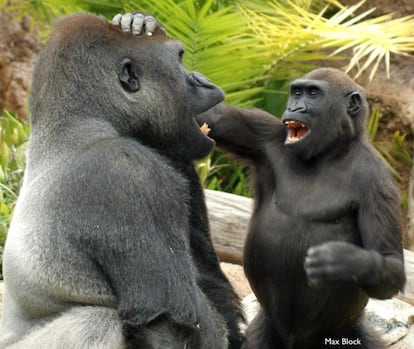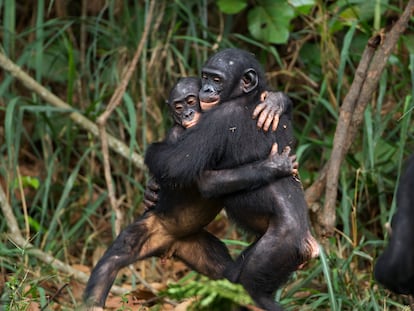Great apes are pranksters too
A study with groups of bonobos, chimpanzees, orangutans and gorillas shows that they share humans’ capacity for levity

Like humans, great apes are ticklish, they laugh and play. And it has now been confirmed that they also tease each other. The study of interactions within groups of bonobos, chimpanzees, orangutans, and gorillas shows that some, especially the juveniles, pull the adults’ hair, tap them on the back and run away, or stand directly in front of an adult with their faces almost touching. For the authors of this new study, the fact that hominid species, including humans, share the ability to joke, indicates that 13 million years ago, when their lineages diverged, this dimension of humor already existed, and it would indicate that teasing had, and still has, an enormous evolutionary role.
Young humans already play pranks on their parents from the age of seven or eight months, when they hide objects from them, jump on them, or have fun disobeying them. Although it is not as elaborate as telling a joke or playing games, these behaviors are essential in social interaction.
This “playful teasing,” as primatologist Josep Call calls it, has several traits that differentiate it from play: it is unidirectional, it seeks to provoke the victim, it is usually surprising, it is repeated until the other responds and, almost always, while deliberately looking at them. A large group of primatologists recorded dozens of hours of juveniles of the four species of great apes from different zoos and research centers.
According to their results, published in the scientific journal Proceedings of the Royal Society B, primatologists recorded around 500 non-violent social interactions and, of them, around 140 were classified as jokes, mockery, or ridicule.
The first result of the study is that adults do not play jokes, they suffer them. On only two occasions, both the prankster and the victim were adults. The rest of the interactions were initiated by the juveniles in each group. The study sought to record the juveniles, who could hide interactions among the adults. By species, the most playful seem to be chimpanzees (with 84 events), followed by orangutans and bonobos, and then gorillas (a long way behind, with only 7 events).
The authors of the work remind us that comparisons between species cannot be made due to the small sample size (34 individuals, including 5 juveniles). Although most of the provocations were directed at the adults in the group, the victims were rarely the mothers. This observation goes in the opposite direction to the observed centrality of the maternal-filial relationship in these groups. Among bonobos, for example, the mother helps the son in his relationships with females. And orangutan babies depend entirely on what their mothers teach them.
“The orangutan Aisha and the bonobo Belle never made fun of their mothers,” details the researcher at the Max Planck Institute for Animal Behavior, Development, and Evolution of Cognition (Germany) and lead author of the study, Isabelle Laumer. For their part, one of the two young chimpanzees in the sample tested their parents’ patience 14% of the time, and the other teased them 8% of the time. “The exception was the young gorilla Denny, who directed his teasing behavior towards his mother or father most of the time (71% and 14% respectively),” she adds. But, again, the sample limits generalizations. The team plan to expand the study to a larger number of animals.
Of the 18 teasing or joking behaviors that the researchers identified, the most common were pushing, hitting, getting in the way, and annoying. They also highlighted pulling hair and taking objects or food, even if it was not to eat it. In almost all of these cases, they did so without taking their eyes off the victim. As happens among humans, looking at the other while playing a joke, especially if it is surprising or annoying, avoids misinterpretations. In fact, only 5% of the responses were considered violent. And there was a very human pattern too: the repetition of the action if the target of the behavior did not respond. Almost all the juveniles insisted on bothering until they got the target’s attention. For the authors, this pattern reinforces their idea that there is an intention behind these behaviors.
In the images (see video above), the juveniles tease and run away, but they always end up looking at the individual being provoked. Many of these behaviors seemed to be used to prompt a response, or at least to attract attention. “It was common for provocateurs to repeatedly shake or swing a body part or object in the middle of the target’s field of vision, hit or poke them, interrupt their movements, pull their hair, or engage in other behaviors that were extremely difficult to ignore,” says Erica Cartmill, from the department of anthropology at the University of California Los Angeles and senior author of the research. Among the responses of those being provoked, patience is the most common: 27% ignored the pranksters. In another 24%, the matter was settled with a slap or other mild aggression, and 17% simply walked away.
The authors of the study highlight that the existence of these jokes and playful provocations in the four species of great apes and in humans, even before they learn to speak. This suggests that our common ancestor, which diverged about 13 million ago for years, already had these behaviors. “To unravel the evolution of humor in our species, we plan to also study teasing and play behavior in others. We now know that the four great apes indulge in playful pranks. The next step would be to investigate whether other species of primates and other animals with large brains also show this behavior,” says Laumer.
The primatologist at the University of Saint Andrews (United Kingdom) Josep Call, who did not take part in this study, has been studying the complexity of both the mind and social relationships in primates for years, including some that could be similar to friendship between humans. “Teasing is something that is seen very often among juvenile chimpanzees and sometimes among adults. It is part of game behavior, typically in a relatively friendly way, although sometimes things get out of hand and what starts as a game turns into an aggressive episode,” he says in an email. The researchers recalled that Jane Goodall and other field primatologists had already mentioned similar behaviors in chimpanzees many years ago. Chilean scientist Isabel Behncke has also investigated laughter in the chimpanzee’s sister species, the bonobos. But this new study is the first to systematically analyze playful teasing in all four great apes.
Regarding the function of jokes, Call is more cautious. He believes it is necessary to carry out larger studies specially designed to study these behaviors, but he suggests one idea: “One possibility is that it is a way for juveniles to see how far they can go with other individuals.” In humans, this would fit with practical jokes. In fact, this type of behavior flirts with play and violence at the same time. “Later on, these behaviors, especially in males, become more serious and aggressive and adolescent males use them to intimidate other individuals and climb positions in the social hierarchy,” Call concludes.
Sign up for our weekly newsletter to get more English-language news coverage from EL PAÍS USA Edition
Tu suscripción se está usando en otro dispositivo
¿Quieres añadir otro usuario a tu suscripción?
Si continúas leyendo en este dispositivo, no se podrá leer en el otro.
FlechaTu suscripción se está usando en otro dispositivo y solo puedes acceder a EL PAÍS desde un dispositivo a la vez.
Si quieres compartir tu cuenta, cambia tu suscripción a la modalidad Premium, así podrás añadir otro usuario. Cada uno accederá con su propia cuenta de email, lo que os permitirá personalizar vuestra experiencia en EL PAÍS.
¿Tienes una suscripción de empresa? Accede aquí para contratar más cuentas.
En el caso de no saber quién está usando tu cuenta, te recomendamos cambiar tu contraseña aquí.
Si decides continuar compartiendo tu cuenta, este mensaje se mostrará en tu dispositivo y en el de la otra persona que está usando tu cuenta de forma indefinida, afectando a tu experiencia de lectura. Puedes consultar aquí los términos y condiciones de la suscripción digital.










































